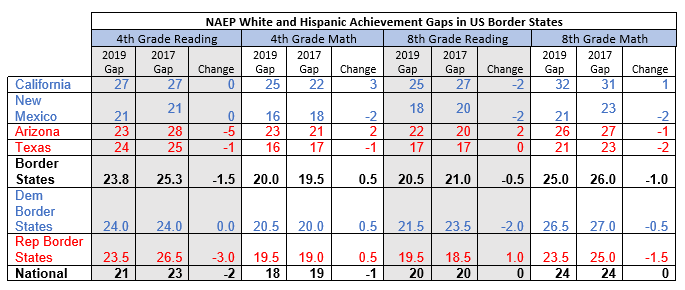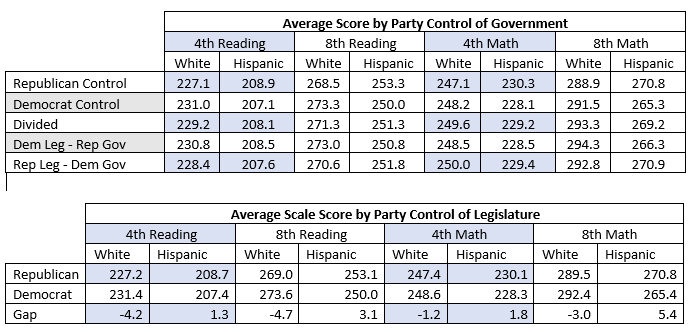
![]()
Last week Education Next published predictions from leading education scholars about how the 2019 National Assessment of Education Progress (NAEP) test results would shake out. The boldest prediction came from Morgan Polikoff, an associate professor at the University of Southern California.
Polikoff anticipated that President Donald Trump’s “racism” and “attacks on Latinix people in particular” would cause an increase in the achievement gap between whites and Hispanics, with the largest gaps growing in border states and states controlled by the Republican Party.
You can read his full prediction here.
Polikoff is correct that America is more politically polarized today than in many decades, so it’s clearly worth exploring the prediction. But the results suggest Polikoff appears to either grant Trump far more power over student achievement than is realistic, or assumes students are more fragile than they really are. Perhaps both.
Either way, his hypothesis is not only incorrect, but we find larger achievement gaps in Democratic-controlled states than Republican ones. In fact, Democratic-controlled states have less achievement equity than Republican states.
First, the border states:

Border states’ achievement gaps and changes in achievement gaps are similar to the rest of the U.S. Border states controlled by Democrats perform slightly worse than Republican ones, though this difference is mainly driven by California.
States with a Republican “trifecta” — that is, one-party control of both houses of the legislature and the governor’s office — see smaller racial achievement gaps in fourth-grade reading, eighth-grade reading, fourth-grade math and eighth-grade math than Democratic trifectas. Democratic-controlled states, on average, performed worse compared to states with divided governments. States with Republican legislatures and Democratic governors, on average, performed better than states with Democratic legislatures and Republican governors.

There were 13 states with Democratic trifectas and 21 states with Republican trifectas. Twelve states had divided governments, though Nebraska has a unicameral legislature instead of a traditional bicameral (house and senate). The National Conference of State Legislature’s database was used to determine party control.
The results are the same when examining control of the state legislature only. There were 29 states with full Republican control of the legislature and 16 states with full Democratic control. States with insufficient Hispanic students to provide a score were dropped from the comparison.

The achievement gap between 2017 and 2019 was also more likely to decline in Republican trifectas than Democratic trifectas. Republican trifectas did see an increase in the eighth-grade reading gap, but Democratic trifectas saw a much larger widening of the fourth-grade math gap. Divided governments performed better than Democratic trifectas, except on eighth-grade reading. States with Republican legislatures, but Democratic governors, performed better than those with Democratic legislatures and Republican governors.
Negative numbers in the chart below mean the gap between white and Hispanic students closed. A positive number represents an increase in the achievement gap.

When examining only one-party control of the legislature, Democratic-controlled states perform worse across the board on the change in the achievement gap.

Finally, I checked to see if the Democratic achievement gaps might simply be due to higher overall performance. Democratic-controlled states are, on average, much better at teaching white students than Republican-controlled states but are worse at teaching Hispanics. This remains true for trifectas and one-party legislative control.

In other words, Republican-controlled states are more likely to provide equitable education outcomes than Democratic states. If racism is the cause of achievement gaps, as Polikoff hypothesized, it certainly isn’t more pronounced in Republican states. States under Democratic control, however, might want to look inward.


